Culture
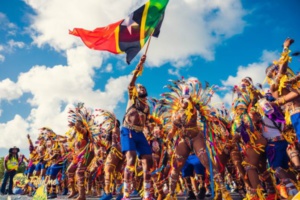 Culture is the combination of the arts, beliefs and institutions created by a group of people that share common geography. Here on the Islands of St. Kitts and Nevis, our culture provides a fascinating window into the distant past, Indigenous, African and European influences. It is a rare treasure chest of traditions and customs brought together from very different lands by very different people. You can see it in the way we dance, taste it in the way we cook, and hear it in the stories we tell.
Culture is the combination of the arts, beliefs and institutions created by a group of people that share common geography. Here on the Islands of St. Kitts and Nevis, our culture provides a fascinating window into the distant past, Indigenous, African and European influences. It is a rare treasure chest of traditions and customs brought together from very different lands by very different people. You can see it in the way we dance, taste it in the way we cook, and hear it in the stories we tell.
A beloved tradition
One of the most cherished traditions in our treasure chest of cultural riches is our carnival at Christmas time, when our Clowns, Moko-Jumbies, Masquerade, Bull, and Actors parade in a joyous display of island pride. Culturama, the annual cultural festival of Nevis, is celebrated during the Emancipation Day weekend, the first week of August. The festivities include many traditional folk dances, such as the masquerade, the Moko jumbies on stilts, Cowboys and Indians, and Plait the Ribbon, a May pole dance.
The Art of Masquerade
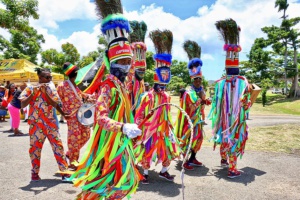 In St. Kitts and Nevis, Masquerade is an art form. Uniquely Kittitian and Nevisian, it is the grand display of our festivities, a cultural evolution that has taken place over the course of 300 years. Paraders wear tall peacock-feathered headdresses, masks, and fringed aprons that reach just above the knees. The entire costume is decorated with bangles, mirrors and ribbons.
In St. Kitts and Nevis, Masquerade is an art form. Uniquely Kittitian and Nevisian, it is the grand display of our festivities, a cultural evolution that has taken place over the course of 300 years. Paraders wear tall peacock-feathered headdresses, masks, and fringed aprons that reach just above the knees. The entire costume is decorated with bangles, mirrors and ribbons.
Dance experts have identified elements of European and African genres, which include the “Wild Mas”, the Waltz, Quadrille, the Rhumba, the Fertility Dance, the Fine Dance, the Jig and the Boillola. The “Quadrille”, which has its roots in 17th-Century France, is the first dance. It is a slow, structured couple’s dance. The second dance, the “Fine”, picks up the pace. It demands greater skill as the dancers work their way, on one foot, towards each other in the centre of the ring. There they perform a Fertility Dance that is traceable to the mating dance of Africa.
The real spectacle comes when the masquerades break into a frenzy of “Wild Mas”, throwing their tomahawks into the air. This dance is typical of the African war dance that has been performed over millennia. The next dance is the “Jig”. Here the dancers display their skill with the tomahawk, with their right foot hooked behind their left.
This dance follows right into the “Boillola”, another dance movement where the tomahawk is held between the dancer’s legs, while the dancers jump and clap to the music, moving from side to side. European roots are put on parade when the dancers pair off into couples and perform the Waltz to a moderately fast triple meter.
Moko-Jumbies and African mythology
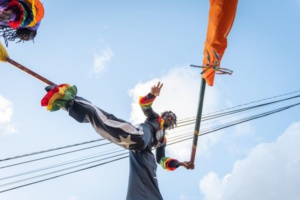 Once a year African mythology brilliantly comes to life and walks among us on St. Kitts and Nevis. Dressed in long colorful gowns, Moko-Jumbies dance on six to eight-foot stilts to the delight of everyone along the parade route. Although we may never know for certain, many theories surround their costumes and the dance they perform. One theory is that Moko is the name of the African God of Vengeance. Others believe it is a corruption of the word macaw, the name of a very tall palm tree covered with thorns, since the headpieces of Moko-Jumbies resemble the heart of the macaw plant when it is in full bloom.
Once a year African mythology brilliantly comes to life and walks among us on St. Kitts and Nevis. Dressed in long colorful gowns, Moko-Jumbies dance on six to eight-foot stilts to the delight of everyone along the parade route. Although we may never know for certain, many theories surround their costumes and the dance they perform. One theory is that Moko is the name of the African God of Vengeance. Others believe it is a corruption of the word macaw, the name of a very tall palm tree covered with thorns, since the headpieces of Moko-Jumbies resemble the heart of the macaw plant when it is in full bloom.
Beware of the Bull
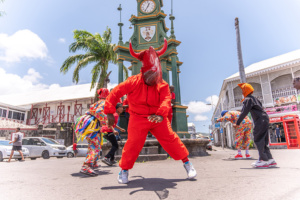 Don’t worry. That’s just a Kittitian or Nevisian dressed in red with a bull headdress coming down the street. And when he goes into a wild frenzy causing chaos and havoc, he’s only retelling the story of an incident that happened at the Belmont estate back to 1917. As it is told, the prize bull of that property’s manager fell ill, only to miraculously revive. It is this revival that is acted out in graphic detail causing humor and havoc as the bull runs wild among spectators.
Don’t worry. That’s just a Kittitian or Nevisian dressed in red with a bull headdress coming down the street. And when he goes into a wild frenzy causing chaos and havoc, he’s only retelling the story of an incident that happened at the Belmont estate back to 1917. As it is told, the prize bull of that property’s manager fell ill, only to miraculously revive. It is this revival that is acted out in graphic detail causing humor and havoc as the bull runs wild among spectators.
Bring in the Clowns!
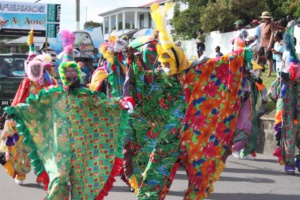 For hundreds of years our Clowns have been a big part of our cultural festivals. This troupe of up to fifty players wear floppy, colorful costumes decorated with tiny bells that fill the air with a delightful jingle. The punctuating crack of the Hunter, a leather whip carried by each performer, serves to keep them in sync with the rhythms of their accompanying String Band. In the same tradition of all local folk dances, our clowns wear pink wire mesh masks to hide their identity and allow for total lack of inhibition. As they serpentine behind and between each other, the elegance and grace of this fun-loving flock of Kittitians and Nevisians is truly a spectacle to behold.
For hundreds of years our Clowns have been a big part of our cultural festivals. This troupe of up to fifty players wear floppy, colorful costumes decorated with tiny bells that fill the air with a delightful jingle. The punctuating crack of the Hunter, a leather whip carried by each performer, serves to keep them in sync with the rhythms of their accompanying String Band. In the same tradition of all local folk dances, our clowns wear pink wire mesh masks to hide their identity and allow for total lack of inhibition. As they serpentine behind and between each other, the elegance and grace of this fun-loving flock of Kittitians and Nevisians is truly a spectacle to behold.
